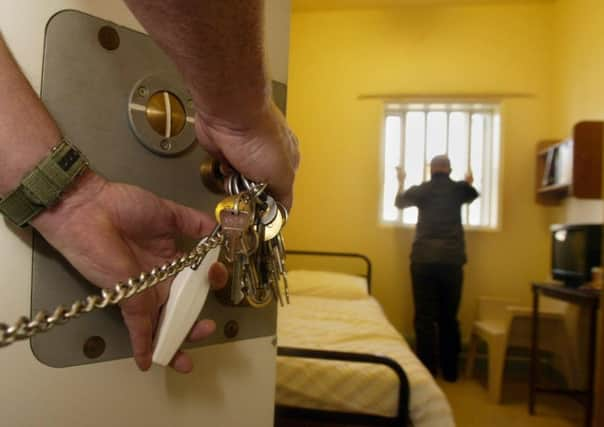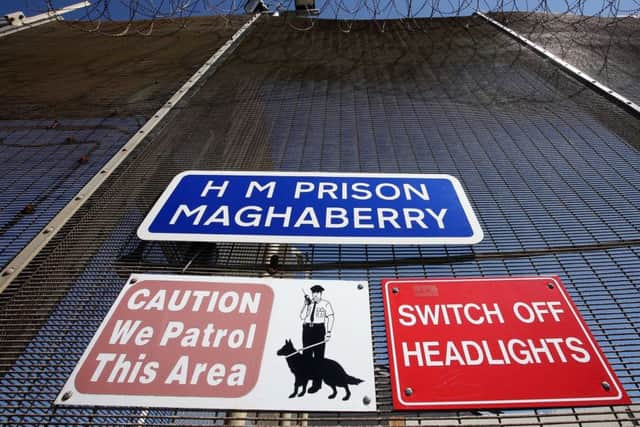Report describes prisoners making shields, weapons, and burning storehouse


The incident unfolded at Erne House in the prison on April 26, 2015.
An unannounced inspection in November that year found that the Erne House unit held “up to 130 mostly determinate sentence and life sentence prisoners”.
Advertisement
Hide AdAdvertisement
Hide AdIt is understood the wing does not cater for those of any particular political or paramilitary background.


The report this week showed that “exceptionally poor operational judgement” had been exercised over the incident, which is characterised as “wholly preventable”.
UUP justice spokesman Danny Kennedy said he was “very concerned” about the report’s findings.
The report – compiled by governors of two other UK prisons, and published on Wednesday – said problems began to flare in Erne House on April 25, when a false alarm was sounded, resulting in the whole wing being locked up.
Advertisement
Hide AdAdvertisement
Hide AdDuring this time, a prisoner refused to be locked in his cell and staff had to restrain him.


This same prisoner was “found to be one of the main protagonists to the events the following day,” the report said.
A number of prisoners damaged their cells and caused disruption during the day, and the jail authorities decided that these 11 prisoners must be exercised separately to the rest. the following day.
During one exercise sessions, beginning at 12.30pm on April 26, six of these 11 disruptive prisoners began damaging windows around the exercises yard.
An officer notified the control room of this at 12.56pm.
Advertisement
Hide AdAdvertisement
Hide AdThe report then says these prisoners were seen “making weapons and shields out of perspex (from broken windows) and being handed makeshift weapons via the prisoners who were located in their cells overlooking the yard”.
A small fire was started in the yard, and quickly extinguished.
By 1.30pm, a team of 30 “control and restraint staff” and two dog handlers were in full protective gear, ready to intervene.
The report notes that an intervention plan had been drawn up by the Security Senior Officer, and then describes a series of calls made by various senior prison staff.
Advertisement
Hide AdAdvertisement
Hide AdAt about 2.08pm “prisoners on the exercise yard started a second fire in the centre of the yard”.
This had perspex placed on it resulting in a large amount of black smoke.
Initial efforts to extinguish it failed because of low water pressure, and the fire brigade were called.
They arrived at 2.27pm, and 12 minutes later the “governing governor” also arrived at the prison (he is the most senior staff member, as opposed to the duty governor, for instance).
Advertisement
Hide AdAdvertisement
Hide AdThree separate requests – at 2.35pm, 2.40pm and 2.46pm – were made to the prisoners to surrender, and during this time the prisoners were seen to wave a white flag “with the clear intention of wanting to surrender”.
However, the report says “a surrender was not authorised”.
It adds: “As a consequence of this lack of action, the six prisoners then went onto break into a store adjoining the exercise yard at 1535 hours (3.35pm).
“This store held chemicals, bed sheets, toilet rolls and large quantities of other cleaning materials, the prisoners quickly set a fire to this store.”
At 3.38pm – two hours and 42 minutes after the disorder was first reported – prison staff were sent in to clear the yard.
Advertisement
Hide AdAdvertisement
Hide AdThe fire brigade tackled the blaze, whilst cells overlooking the yard were evacuated.
CONCLUSIONS AND FALLOUT:
The report concludes: “Numerous opportunities were presented throughout the afternoon to bring this incident to a conclusion, either through intervention, prevention or surrender.”
Dubbing the whole event “wholly preventable,” it found that “exceptionally poor operational judgement from within the Silver Command Suite” had “directly contributed to the final events that unfolded”.
It notes that just three days earlier an event with “striking similarities” had occurred, but was properly resolved.
Advertisement
Hide AdAdvertisement
Hide AdIt also said: “The lack of comprehensive, up to date incident management training for all managers from Senior Officer upwards is also a cause to why this incident developed in the manner it did.”
It recommends a “root and branch review of incident management” across all three Northern Irish prisons, plus contingency plan exercises, and more.
The report also notes that the “governing governor was unable to be interviewed during this inquiry”, even though this “would have been critical in terms of trying to understand why there were clear delays to the final resolution”.
Danny Kennedy MLA said on Friday: “There is no doubt the Maghaberry has been a very challenging environment for prison officers and management, and the difficulties faced on a daily basis should not be under-estimated.
Advertisement
Hide AdAdvertisement
Hide Ad“I note the six recommendations of the independent inquiry and I fully support their implementation.
“There is no question that a review of training and corporate governance should be conducted to ensure that Northern Ireland’s prisons are as safe environments as possible for both staff and prisoners.
“The UUP has long voiced its concerns at the situation within Maghaberry, with particular regard to staffing levels, staff safety and staff morale. Last November HM Chief Inspector of Prisons in England and Wales, Nick Hardwick described it as ‘a prison in crisis’ with ‘unsafe and unstable conditions’ and ‘the most dangerous prison in the UK.’
“Clearly change is required.”
‘LESSONS HAVE BEEN LEARNED’:
The report which is available to the press and public is only a shortened version; the Department of Justice (DoJ) said that the full one is too sensitive to release.
Advertisement
Hide AdAdvertisement
Hide AdIt said: “NIPS (the Northern Ireland Prison Service, for which it is responsible) accepts the findings of the inquiry which highlighted concerns in regards to concerted indiscipline by prisoners, staff incident management and around fire safety.
“The report also makes a number of recommendations and these also have been accepted.
“Actions are being put in place to ensure all critical lessons are learned, including refresher training for senior governors and their teams who are responsible for managing serious incidents in prisons, and a review of health and fire safety procedures.
“Significant learning has been gained from this incident across a broad range of issues at Maghaberry and the wider Prison Service and much work has been completed since the incident.
“With a new Governor and effective and robust processes in place, NIPS will ensure any future incidents are managed effectively and safely.”